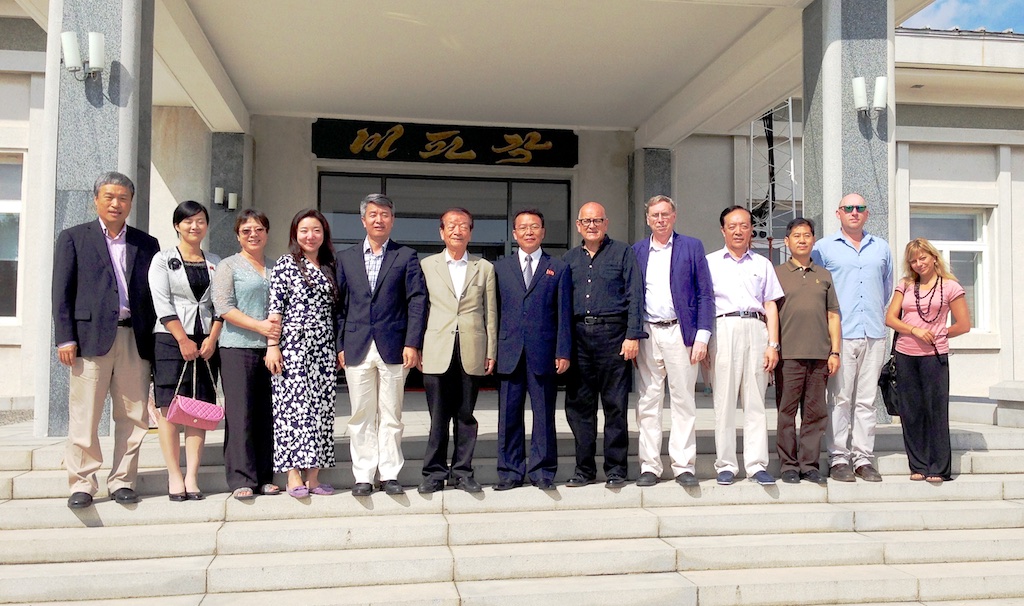Field Trip to Rason, DPRK and Yanji-Hunchun, China
You are here

The field visit to the Rason Special Economic Zone, Rajin-Sonbong, was organized by the NEAEF and the Delegation was led by Drs. Lee-Jay Cho and Glyn Ford during August 31—September 2, 2014
Following on from the conference, a small group of participants made a field trip to Yanji and Rason, to look at this critical area of Northeast Asia first hand. The participants assembled in Yanji the morning of August 30, right after the end of the conference. The arrangements had been coordinated by China API on the Chinese side of the border and by Glyn Ford’s office in conjunction with the Korea Economic Development Association on the DPRK side.
On the Chinese side in the afternoon of August 30, a meeting was held with Mr. Fu Wen Biao, the Vice Chairman of Yanbian and his staff in which he spoke about the progress of Yanji and the region. The total area of Yanbian is about half the size of South Korea. Although the cities of Yanji and Hunchun were growing, the total population of the Korean autonomous zone was not. The two cities, had grown impressively over the past decade, but the Vice Chairman was anxious to develop the resources of the rural hinterland.
The next morning, the group left for Hunchun and the border crossing in a privately hired bus with a Chinese driver. The border was opened for the first time to civilians in 1996, and the Chinese have built an impressive customs and immigration building which is normally closed on a Sunday. Plans in the terminal building showed that the Chinese would be building an even larger customs and immigration center and an entirely new modern bridge shortly. Regular bus services run between Hunchun and Rason, and seem to operate about hourly on week days during daylight hours. The buses we passed on our return seemed crammed with people.
After crossing the long truss girder bridge dating from the end of the Korean war, the bus was diverted onto an unmade road to the Korean customs clearance and immigration hall. There we were met by our host Vice Chairman Yoon Yong Sok of the Korea Economic Development Association, and his staff who had come from Pyongyang, especially for our trip. The local Rason staff were also on hand.
Twenty-one years ago, when Dr. Lee-Jay Cho first visited there, on the occasion of the inaugural Rason Development Program field trip to Rason, the infrastructure, (such as buildings, paved roads, hotels, etc.) was in a very early stage. But everyone was greatly impressed by the strategic geographic potential for dynamic future development as a major transportation hub centered in Rajin and Sunbong. On this recent occasion we witnessed that there has been significant development and change.
All evidence suggests that all the development has been in the past two to three years, and that it is accelerating as Rason is pulled into the regional Chinese economy, itself growing fast around the two major cities of the region. Inside Rason, the rising income in real convertible currency is creating domestic demand. Critical in this appeared the late 2011 agreement with the Chinese to co-develop the zone and the mid 2012 paving of the road to the bridge with China, plus guarantee of electricity. Manufacturing in Rason and shipping by road to Hunchun appears to be more prevalent than shipping outwards by sea, probably the result of the sanctions both international and local sanctions applied by Japan and S. Korea.
The new port facility built by the Russians and completion of the renovation of the dual gauge railway between Russia and Rason, which was the subject of the South Korean – Russian summit and subsequent visits by South Koreans to Rason, was not yet playing any real part in the development of the region. However agreements on bilateral trade between Russia and the DPRK made in 2014 would undoubtedly bring a new growth element to the zone.
In conclusion all the delegation was impressed by the results achieved in Rason, and its potential to grow to become the biggest city between Vladivostok and Ulsan in the foreseeable future. It was agreed that this kind of field trip was highly valuable as an annex to the annual conference.
All of the members in the delegation were impressed by the environmentally clean landscape of Rason, with its valuable marine and other resources that can be preserved for long-term future economic value and appreciation. The Rason Special Economic Zone, by linking with the neighboring territories with their complementary resources and connecting with their infrastructure, will have a great and dynamic potential for sharing economic development and enhancing the quality of life in the region.

